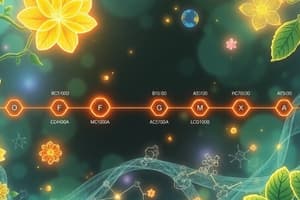Podcast
Questions and Answers
Which of the following compounds is NOT a product of the shikimate pathway?
Which of the following compounds is NOT a product of the shikimate pathway?
- L-phenylalanine
- Chorismate
- L-tyrosine
- Palmitic Acid (correct)
Secondary metabolism is directly involved in growth and development.
Secondary metabolism is directly involved in growth and development.
False (B)
What are the primary precursors in the acetate-malonate pathway?
What are the primary precursors in the acetate-malonate pathway?
Acetyl-CoA and Malonyl-CoA
The conversion of Acetyl-CoA and Acetoacetyl-CoA leads to the formation of _______.
The conversion of Acetyl-CoA and Acetoacetyl-CoA leads to the formation of _______.
Match the following pathways with their products:
Match the following pathways with their products:
Which aromatic amino acid is NOT produced from the shikimate pathway?
Which aromatic amino acid is NOT produced from the shikimate pathway?
Farnesyl pyrophosphate is involved in the synthesis of various terpenoids.
Farnesyl pyrophosphate is involved in the synthesis of various terpenoids.
What is the initial compound formed when Erythrose 4-phosphate reacts with Phosphoenolpyruvate in the shikimate pathway?
What is the initial compound formed when Erythrose 4-phosphate reacts with Phosphoenolpyruvate in the shikimate pathway?
The fatty acid produced in the acetate-malonate pathway is _______.
The fatty acid produced in the acetate-malonate pathway is _______.
Which class of terpenoids contains 15 carbon atoms?
Which class of terpenoids contains 15 carbon atoms?
Flashcards are hidden until you start studying
Study Notes
Shikimate Pathway
- The Shikimate pathway is a metabolic pathway responsible for the biosynthesis of aromatic amino acids in plants, fungi, and bacteria.
- The pathway starts with the reaction of erythrose 4-phosphate and phosphoenolpyruvate to create 3-deoxy-D-arabino-heptulosonate 7-phosphate.
- The aromatic amino acids produced by the Shikimate pathway include phenylalanine, tyrosine, and tryptophan.
- Note: Not all aromatic compounds are biosynthesized by the Shikimate pathway.
Acetate-Malonate Pathway
- The acetate-malonate pathway is a metabolic pathway responsible for the biosynthesis of fatty acids in bacteria and fungi.
- The primary precursors in the acetate-malonate pathway are acetyl-CoA and malonyl-CoA. Malonyl-CoA is produced through a carboxylation reaction from acetyl-CoA mediated by acetyl-CoA carboxylase.
- The conversion of acetyl-CoA and acetoacetyl-CoA leads to the formation of HMG-CoA (3-hydroxy-3-methylglutaryl-CoA), which is a key intermediate in the biosynthesis of terpenoids, steroids, and isoprenoids.
Terpenoids
- Terpenoids are a large and diverse class of organic compounds derived from isoprene units.
- Terpenoids are classified based on the number of isoprene units they contain.
- Sesquiterpenoids contain 15 carbon atoms.
- Farnesyl pyrophosphate is an important intermediate in the biosynthesis of many terpenoids.
Secondary Metabolism
- Secondary metabolism is a term used to describe the biosynthesis of compounds that aren't essential for basic cell function but have important ecological roles.
- Secondary metabolites can be responsible for various functions including:
- Defense against predators and pathogens
- Attraction of pollinators
- Growth regulation
- Competition with other organisms
- Secondary metabolism is often related to specialized metabolic pathways such as the Shikimate pathway and the acetate-malonate pathway.
- Aromatic amino acids are essential building blocks for proteins, but they can also be used by plants to produce secondary metabolites, which can act as antibiotics or pesticides.
Studying That Suits You
Use AI to generate personalized quizzes and flashcards to suit your learning preferences.




